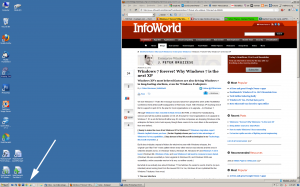Why Windows 7 is the Next XP
August 23rd, 2012Why? If you ask me, it’s because I can make Windows 7 look and act pretty much like XP.
Yep, after more than a decade of using Windows XP, I’ve finally moved to Windows 7 on my main rig. Microsoft isn’t pulling the plug on XP until 2014, but there are a couple of 64-bit only applications that I want to use and I wasn’t willing to risk the possibility that Microsoft will stop selling Windows 7 after the Windows 8 disaster ships in October, so I just took the plunge.
I’ve mostly finished with the process of getting the system set up the way I want, which means that I’ve made 7 look a lot like XP.
The one thing I couldn’t figure out at first was how to restore the quick launch bar along the bottom near the start button. A Google search later, I found: Add the Quick Launch Bar to the Taskbar in Windows 7.
Ahh. Much better. It looks so much like XP now that I sometimes space out and forget that I’m using 7. *chortle*
Changing the topic a bit, here are a few comments about my first SSD experience:
I installed Windows 7 on an OCZ Vertex 4 128GB SSD. Although my somewhat old (2008) computer doesn’t support SATA3 speeds, I thought I’d at least get a fast drive for when I decide to shell out for a new motherboard, processor and RAM.
After seeing how fast this thing runs, even on this old Core 2 Quad Q9400 system, I’ve cancelled plans to build a new rig. While it’s a slight bummer to see the Vertex 4 throttled back to about half its maximum throughput—due to the legacy SATA2 interface—the thing just flies compared to how it used to go with the platter based drive. I can’t get over seeing Windows 7 boot all the way to the desktop in 17 seconds. Haha.
There probably aren’t many nerds left who haven’t stepped up to SSDs by now, but I was one of the holdouts. I’ve only had this Vertex 4 for two days and when I boot back into my plain old 5400RPM drive, I’m already thinking, “I’m never going back to conventional drives, at least not for the OS and applications.” So, in short, yep: Believe the hype about how great SSDs are.
Via: Infoworld:
With Windows XP reaching end of life for support in April 2014, the plan for most organizations is to upgrade — to Windows 7.


I made the move to a SSD OS/boot drive a couple of years ago and can honestly say it’s the best money you can spend if you want a faster machine.
However, be very aware that the reliability may not be the same as spinning HDs. The drive I originally bought started corrupting data, eventually leading to the machine freezing during Windows startup. By that point I was keeping image backups on other storage, so was able to restore each time until the drive finally gave up the ghost for good.
My recommendation is to use SSDs for OS/apps and data you need to be fast, but keep regular full-image backups so you can quickly restore should the SSD fail. Keep all data you care about on mirrored or otherwise redundant storage, and back that up also.
Keep data you REALLY care about in an encrypted container spread across several locations (eg Dropbox etc).
Yes, I’ve read stories about this issue. It didn’t bother me much because I have no faith in platter based drives anyway. I always assumed that I was using Western Digital drives – which you can almost count on to fail.
OCZ and Intel have five year warranties on some of their SSD drives now. Most platter based drives are one or two years.
Windows 7 is fine.
Windows 9 will be fine.
Microsoft is the opposite of star trek movies 😉